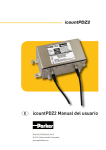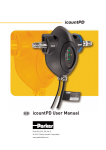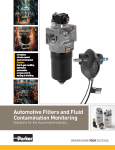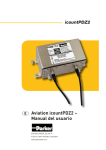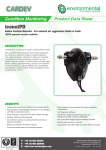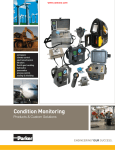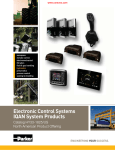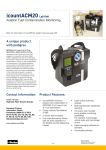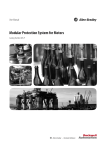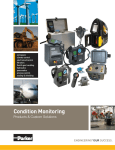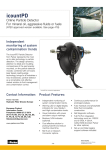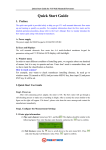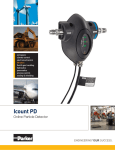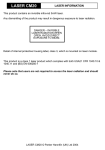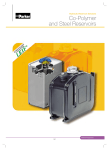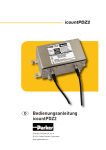Download icountPDZ2 User Manual
Transcript
icountPDZ2 g icountPDZ2 User Manual B.84.833_IPDZ2M_GB_Ver A © 2010, Parker Hannifin Corporation www.parkerhfde.com g Overview Parker Hannifin’s IPD Z2 is an on-line laser particle detector. This mineral based hydraulic fluid contamination detector is designed for use in ATEX category 3 areas and is housed in a stainless steel IP69K approved enclosure. The unit has two size 06L EO 24° cone-end hydraulic connections that allow the fluid to be transferred through the unit for analysis. The electrical supply and communication is made via two M12 Ultra Lock IP69K approved connectors. Conditons for safe use To ensure compliance with the certification, users are NOT permitted to open the unit under any circumstances. Doing so will invalidate the unit’s calibration and it would NOT be suitable for Hazardous area use. 2 Parker Hannifin icountPDZ2 g Contents Overview....................................................................................................2 Conditons for safe use...............................................................................2 Laser Information......................................................................................4 Declaration of Conformity and Certificate of Manufacture.......................4 Product identification label.......................................................................5 Introduction.............................................................................. 6 Principles of operation..............................................................................6 Benefits......................................................................................................7 Technical specification..............................................................................8 Software default settings..........................................................................9 Product features......................................................................................10 Dimensions for installation.....................................................................10 Connections............................................................................ 11 Hydraulic connection...............................................................................11 Flow control.............................................................................................12 System 20 sensor connection.................................................................13 Electrical connections.............................................................................14 Variable current output settings.............................................................19 Variable voltage output settings..............................................................20 CAN-bus output option............................................................................20 Moisture sensor output settings.............................................................20 Digital Display Unit connection...............................................................21 RS232 connection....................................................................................23 Software................................................................................. 24 icountPD Setup Utility software..............................................................24 Microsoft Windows® HyperTerminal connection....................................27 Communication protocol.........................................................................29 Reference............................................................................... 34 Optional wiring configuration..................................................................34 Optional Limit Relay hysteresis..............................................................34 Interpreting data......................................................................................36 ISO/NAS/SAE comparison chart.............................................................40 Component cleanliness guidelines.........................................................41 Viscosity charts........................................................................................42 ISO contamination charts........................................................................43 Ordering Information...............................................................................46 Parker Hannifin icountPDZ2 3 g Laser Information This product contains an invisible infrared 5mW laser. Any dismantling of the product may result in dangerous exposure to laser radiation. DANGER INVISIBLE LASER RADIATION WHEN OPEN. AVOID DIRECT EXPOSURE TO BEAM. CAUTION: Users are not required to access the laser radiation source and should never do so. Declaration of Conformity and Certificate of Manufacture CE conformity The IPD Z2 is in conformity with the protection requirements of the following European Standards in English: ■■ Directive 94/9/EC of the European Parliament and the Council, for equipment intended for use in potentially explosive atmospheres (ATEX). ■■ EN 60079-0:2009, Electrical apparatus for explosive gas atmospheres General requirements. ■■ EN 60079-15:2005, Electrical apparatus for explosive gas atmospheres – Construction, test and marking of type of protection “n” electrical apparatus. ■■ EN 61241-1:2004, Electrical apparatus for use in the presence of combustible dust. Protection by enclosures ”tD” ■■ IECEx 60079-0:2006 ed 4.0 (IECEx 60079-0:2007 ed 5.0) – Electrical equipment for explosive gas atmospheres – Part 0: General requirements ■■ IECEx 60079-15 :2005 ed 3.0 – Electrical apparatus for explosive gas atmospheres – Part 15: Construction, test and marking of type of protection ”n” electrical apparatus ■■ IECEx 61241-1:2004 ed 1: IECEx Test Report for IEC 61241-1 (2004) ed 1.0 – Electrical apparatus for use in the presence of combustible dust – Part 1: Protection by enclosures “tD” The Product(s) described above are in conformity with the essential requirements of the following directives: 89/336/EEC amended by 92/31/EEC, 93/68/EEC and repealed by 2004/108/EEC Harmonised standards: EN61000-6-3:2007 Electromagnetic compatibility – Part 6-3: Generic standards – Emission standard for residential, commercial and light-industrial environments. EN61000-6-2:2005 Electromagnetic compatibility (EMC) – Part 6-2: Generic standards – Immunity for industrial environments 4 Parker Hannifin icountPDZ2 g Product identification label The identification label attached to the enclosure (an example is given below) is explained in the table that follows: 5 1 2 3 4 7 8 bk bl 6 9 Item Field 1 2 3 Values Part Number icountPDZ2 D.O.M. Date of manufacture Serial Number The serial number consists of eight digits, for example: GD6NN001 (‘GD’ is the month and year; ‘6NN’ is the product group; the last three digits are entered sequentially through a month, reverting to ‘001’ at the beginning of each month) 4 5 Manufactured Country of manufacture (United Kingdom) Name and address of manufacturer Parker Hannifin (UK) Ltd, Filter Division Europe, Condition Monitoring Centre, Brunel Way, Thetford, Norfolk, IP24 1HP, UK 6 ATEX certification number Ex = European mark II = Non-mining 3 = Equipment category (Zone 2/22) GD = Type of explosive atmosphere (G = Gas, D = Dust) 7 ATEX/IECEx category 3 certificate coding (Gas) Ex = Explosion protected nA = Type ‘n’ (non-sparking) IIC = Gas group T4 = Temperature class (4 = maximum surface temperature of 135°C) Gc = Equipment protection level (G = Gas, c = Zone 2) 8 ATEX/IECEx category 3 certificate coding (Dust) Ex = Explosion protected tc = Protection by enclosure IIIC = Equipment grouping typical dust material Dc = Equipment protection level (D = Dust, c = Zone 2) 9 CE Conformity marking and number of notified body responsible for audit production CE 0518 bk bl Certificate Numbers SIRA 09ATEX4340X IECEx SIR 09.0137X Ambient operating temperature Between -30°C and +60°C Parker Hannifin icountPDZ2 5 g Introduction Introduction Parker Hannifin’s icountPDZ2 represents the most up-to-date technology in solid particle contamination analysis. The icountPDZ2 is a compact, permanently-mounted laser-based particle detector module that provides a cost-effective solution to fluid management and contamination control. Principles of operation The icountPDZ2 measures particle contamination continuously and updates the output options and limit relay every second. Unlike the Parker CM20, LCM20 or MCM20, the unit does not perform a ‘one-off’ test. This means that even if the Measurement Period is set to 60 seconds, the output and limit relay all report the presence of dirt in the oil in just a few seconds – it does not wait until the end of the Measurement Period before reporting the result. The icountPDZ2 has just one setting to control the accuracy, stability and sensitivity of the measurements and that is the ‘Measurement Period’. This can be set from 5 seconds to 180 seconds. The longer the Measurement Period, the more contaminant is measured, averaging out any spikes seen on a smaller sample. The shorter the Measurement Period, the more sensitive the icountPDZ2 is to small slugs of contaminant, but it can also reduce the performance on clean systems. Thus, the user can select how sensitive the icountPDZ2 is to spikes of contaminant, and how quickly it responds to contamination levels above the set point (‘limits’). With a Measurement Period of 100 seconds, the results will be for the last 100ml of oil that has flowed through the icountPDZ2, updated on a second-by-second basis, giving an effectively continuous readout of the level of contamination. Calibration recommendations NOTE: Any servicing or repair work must be carried out by a Parker ATEX approved service centre. Contact your local Parker Hannifin Sales Company for recalibration details. The recommended period between recalibration is 12 months. Please refer to the Parker Hannifin Quality and Servicing booklet (FDCB272UK), supplied on CD. 6 Parker Hannifin icountPDZ2 g Introduction Benefits ■■ Independent monitoring of system contamination trends ■■ Calibration by recognised online principles confirmed by relevant International Organization for Standardization (ISO) procedures ■■ Indicators for Low, Medium and High contamination levels ■■ A low cost solution to prolonging fluid life and reducing machine downtime ■■ Self-diagnostic software ■■ Mineral fluid-compatible construction ■■ Fully PC/PLC integration technology such as: RS232, 0–3V/0–5V, 4–20mA and CAN-bus (SAE J1939) – see the ‘Product Configurator’, page 46, for communication options ■■ Percentage saturation reporting through an integrated moisture sensor – see the ‘Product Configurator’ on page 46, for the moisture sensor option. Parker Hannifin icountPDZ2 7 g Introduction Technical specification Feature Specification Product start-up time 5 seconds minimum Measurement period 5–180 seconds Reporting interval 0–3600 seconds via RS232 communication Principle of operation Laser Diode optical detection of actual particulates International codes ISO 7 – 22, NAS 0 – 12 Calibration By recognised online methods confirmed by the relevant ISO procedures. MTD – Via a certified primary ISO 11171 automatic particle detector using ISO 11943 principles, with particle distribution reporting to ISO 4406:1996 ACFTD – Conforming to ISO 4402 principles with particle distribution reporting to ISO 4406:1996 Recalibration Contact Parker Hannifin Working pressure 2–420 bar (30–6000 PSI) Flow range through icountPDZ2 Note: Flow may be bi-directional 40–140 ml/min (optimum flow 60 ml/min) (0.01 – 0.04 USGPM (optimum flow 0.016 USGPM)) Online flow range via System 20 sensors Size 0 = 6 to 25 l/min (2–7 USGPM) Size 1 = 24 to 100 l/min (6–26 USGPM) Size 2 = 170 to 380 l/min (45–100 USGPM) Ambient storage temperature –40°C to +80°C (–40°F to +176°F) Environment operating temperature -30°C to +60°C (–22°F to 140°F) Fluid operating temperature +5°C to +80°C (+41°F to 176°F) Computer compatibility Parker recommends the use of a 9-way D-type connector. This can be connected to a USB port using a USB-serial adaptor. Note that these connectors/adaptors are NOT supplied with icountPDZ2 units: contact Parker Hannifin for advice. Moisture sensor calibration ±5% RH (over compensated temperature range of +10ºC to +80ºC; +50ºF to +176ºF) Operating humidity range 5% RH to 100% RH Moisture sensor stability ±0.2% RH typical at 50% RH in one year Power requirement Regulated 9–40Vdc Current rating Typically 120mA Certification IP69K rating EC Declaration of Conformity (see page 4). Analogue output options (specified when ordering) Variable current 4–20mA Variable voltage 0–5Vdc, 0–3Vdc (user selectable) CAN-bus to SAE J1939 (e.g. Parker IQAN) Moisture sensor Linear scale within the range 5% RH to 100% RH 8 Parker Hannifin icountPDZ2 g Introduction Software default settings Standard defaults Comms echo OFF Verbose errors OFF STI Sensors used OFF Reporting standards ISO Particle limits 19 / 18 / 15 Measurement period 60 seconds Reporting interval 30 seconds Power-on mode AUTO Auto start delay 5 seconds Date format dd/mm/yy Default if options fitted Relay hysteresis ON Relay operation for particle limits ON Relay operation for moisture sensor ON limits 0–5V/0–3V output voltage range 0–5V Moisture sensor limit 70% Parker Hannifin icountPDZ2 9 g Introduction Product features Four mounting locations (two each side) to suit M8 (5/16”) fixings (supplied) Size 06L EO 24° cone end hydraulic connections (Pipe not supplied) Supply and Limit relay M12, 8-pin Ultra Lock IP69K Rated Male connector. Supply / Limit Cable, 5m (16ft 4in) Product identification label Communication cable M12, 8-pin Ultra Lock IP69K female connector. Communication Cable, 5m (16ft 4in) Dimensions for installation Dimensions are given in mm (inches) Four mounting locations (two each side) to suit M8 (5/16 inch) fixings, supplied. Flange thickness is 2mm (5/64 inch) 10 Parker Hannifin icountPDZ2 g Connections Connections Hydraulic connection Our recommendation is to position the icountPDZ2 as close to the system output as possible whilst controlling the flow to the optimum 60ml/min. This then provides the highest pressure conditions, plus the oil in this position is indicative of the reservoir’s oil condition. The IPDZ2 is supplied with two size 06L EO 24° cone-end hydraulic connections. For hydraulic connection, ensure that the hydraulic/pipe connection fitting is compatible with the size 06L EO 24° cone bulkhead fitting. Assembling the EO nut fitting Step 1 Press the tube-end firmly into the assembly core. Turn back the nut for easy tube insertion and fit the nut hand tight, then tighten the fitting until you feel a sharp increase in resistance. 2 Ensure the bulkhead fitting is held with a 17mm spanner and tighten (approximately 1 to 1½ turns). 3 Now remove the pipe and nut to check assembly. The gap between sealing ring and retaining ring must be closed. A little relaxation (approximately 0.2mm) is allowed. If the gap is not closed: Check all components, including the tube. Parker Hannifin icountPDZ2 11 g Connections 4 Assemble the fitting until wrench-tight (without spanner extension). Tighten the fitting firmly by a minimum 1/6 (max ¼) turn (i.e. 1 to 1½ flats) Flow control A pressure compensated, flow control device (Parker Hannifin part number S840074) has been developed to give the icountPDZ2 user greater flexibility. The flow control device enables testing where flow ranges are outside the icountPDZ2 specifications (i.e. 40–140 ml/min), or where pipe diameters do not allow the icountPDZ2 to be installed. Required Differential Pressure Range 5–315 Bar The flow control device fits onto the downstream (outlet) side of the icountPDZ2, connecting through a manifold block via a selfsealing quick connection test point. The differential pressure valve automatically compensates for pressure and viscosity changes, whilst maintaining its flow setting even as the workload changes. The table below is used to select the appropriate valve position: 12 Valve position cSt range 3 20–100 3.8 90–200 4.2 190–320 5 310–500 Parker Hannifin icountPDZ2 g Connections System 20 sensor connection 6 to 25 l/min (optimum flow = 15 l/min) Size 1 24 to 100 l/min (optimum flow = 70 l/min) Size 2 170 to 380 l/min (optimum flow = 250 l/min) 56 Size 0 Size 0 Sensor Ø30 Online flow range via System 20 inline sensors: The required differential pressure across inline sensors is 0.4 bar (minimum) Refer to the ‘Sensor part numbers’ section on page 46 before ordering System 20 sensors. Size 1 Sensor Ø41 66.5 See ‘Inline Sensor Monitors’ (Parker Hannifin Brochure CM013GB1) for more information on System 20 sensors. 95 137 Ø66.7 73.5 Size 2 Sensor 231.3 (All dimensions are in millimetres) IMPORTANT NOTE: P1 and P2 of the System 20 sensors MUST be connected to the icountPDZ2 test points. Ensure that the icountPDZ2 command ‘SSU’ is set to ‘Yes’ when connecting to icountPDZ2 – refer to ‘Communication protocol’ section of this manual for a list of user commands. Contact Parker Hannifin if you require further advice in connecting icountPDZ2 to your system. Parker Hannifin icountPDZ2 13 g Connections Electrical connections The M12 8-pin Ultra Lock connection system uses innovative push-to-lock technology to make a quick but secure connection. The unique O-ring radial seal is operator-independent, so there is no chance of over-tightening or under-tightening. Supply and Limit Relay cable Communication cable M12, 8-pin Ultra Lock IP69K-rated, male connector to unterminated 5m (16ft 4in) Supply and Limit Relay cable. M12, 8-pin Ultra Lock IP69K-rated female connector to unterminated 5m (16ft 4in) Communication cable. IMPORTANT NOTE: The IP69K Ingress Protection is only valid when using the M12 Ultra Lock mating connector cable (supplied). Connecting/Disconnecting Ensure that the locating pin and slot are correctly aligned (to avoid damaging the pins) and push home firmly to connect. To disconnect, pull the Ultra Lock’s metal collar back to release the cable lock and pull the cable boot out squarely. Wiring diagrams Wiring diagrams are provided (on pages 16–17), showing how a digital multimeter may be connected to the Communication cable and the Supply and Limit Relay cable, for both voltage and current options. The connections for an optional moisture sensor (if fitted) are also shown. A diagram for connecting the icountPDZ2 to an external CAN-bus network is given on page 18. 14 Parker Hannifin icountPDZ2 g Connections Communication cable connector � � � � � � Pin configuration diagram M12, 8-pin Ultra Lock IP96K female connector, end view � � Pin number No options fitted (Wire colour recommended) 4–20mA option fitted 0–5V/0–3V option fitted CAN-bus option fitted 1 (White) NOT USED Channel C, ISO 14µm(c) Channel C, ISO 14µm(c) NOT USED 2 (Brown) RS232 Ground (* Pin 5) RS232 Ground (* Pin 5) RS232 Ground (* Pin 5) RS232 Ground (* Pin 5) 3 (Green) NOT USED Channel A, ISO 4µm(c) Channel A, ISO 4µm(c) CAN+ (Hi) 4 (Yellow) NOT USED Channel B, ISO 6µm(c) or NAS (if selected) Channel B, ISO 6µm(c) or NAS (if selected) CAN– (Lo) 5 (Grey) RS232 Receive (* Pin 3) RS232 Receive (* Pin 3) RS232 Receive (* Pin 3) RS232 Receive (* Pin 3) 6 (Pink) RS232 Transmit (* Pin 2) RS232 Transmit (* Pin 2) RS232 Transmit (* Pin 2) RS232 Transmit (* Pin 2) 7 (Blue) NOT USED Moisture sensor channel (if fitted) Moisture sensor channel (if fitted) CAN Ground 8 (Red) NOT USED NOT USED NOT USED NOT USED * Parker Hannifin recommends the use of a 9-way D-type socket with RS232, using the pin configurations given in the above table. NOTE: If the moisture sensor is fitted without the 4–20mA or the 0–5V/0–3V option, then the output is via RS232. Supply and Limit relay cable connector � � � Pin configuration diagram M12, 8-pin Ultra Lock IP69K-rated, male connector, end view � � � � � Pin number No options fitted (Wire colour recommended) 4–20mA option fitted 0–5V/0–3V option fitted CAN-bus option fitted 1 (White) Relay Normally Closed (if fitted) Relay Normally Closed (if fitted) Relay Normally Closed (if fitted) NOT USED 2 (Brown) NOT USED 4–20mA Supply 12–20Vdc 0–5 / 0–3V Supply 12–24Vdc NOT USED 3 (Green) Relay Common (if fitted) Relay Common (if fitted) Relay Common (if fitted) NOT USED 4 (Yellow) Relay Normally Open (if fitted) Relay Normally Open (if fitted) Relay Normally Open (if fitted) NOT USED 5 (Grey) NOT USED NOT USED NOT USED NOT USED 6 (Pink) NOT USED NOT USED 0–5V / 0–3V Supply 0 Vdc NOT USED 7 (Blue) Product supply 0Vdc Product supply 0Vdc Product supply 0Vdc Product supply 0Vdc 8 (Red) Product supply 9–40Vdc Product supply 9–40Vdc Product supply 9–40Vdc Product supply 9–40Vdc IMPORTANT NOTE: It is the responsibility of the end user to ensure that the cable’s braided screen is terminated to a suitable earth bonding point. Parker Hannifin icountPDZ2 15 16 Supply 0Vdc– PSU PSU pin 2 pin 3 pin 4 pin 5 pin 6 pin 7 pin 8 pin 2 pin 3 pin 4 pin 5 pin 6 pin 7 pin 8 Digital multimeter or similar Moisture sensor channel (0–5V/0–3V) output (if fitted) (Blue) Channel B (0–5V/0–3V) output (Yellow) Channel A (0–5V/0–3V) output (Green) Channel C (0–5V/0–3V) output (White) B A Optional switch box C ms (This example shows the switch position set to monitor Channel A) pin 1 Comms cable pin 1 ****V Product supply 9–40Vdc+ (Red) Product supply 0Vdc– (Blue) 0–5V/0–3V supply 0V– (Pink) 0–5V/0–3V supply 12–24V+ (Brown) Supply cable icountPDZ2 Connections g M12, 8-pin connector: 0–5V/0–3V voltage measurement Parker Hannifin icountPDZ2 Parker Hannifin icountPDZ2 4–20mA supply 0Vdc PSU Note that the 4–20mA DC supply must be a separate and dedicated circuit. PSU pin 2 pin 3 pin 4 pin 5 pin 6 pin 7 pin 8 pin 2 pin 3 pin 4 pin 5 pin 6 pin 7 pin 8 Moisture sensor channel (4–20mA) output (if fitted) (Blue) Channel B (4–20mA) output (Yellow) Channel A (4–20mA) output (Green) Channel C (4–20mA) output (White) A Optional switch box C B ms (This example shows the switch position set to monitor Channel A) pin 1 Comms cable pin 1 Digital multimeter or similar ****mA Product supply 9–40Vdc+ (Red) Product supply 0Vdc– (Blue) 4–20mA supply 12–20Vdc+ (Brown) Supply cable icountPDZ2 g Connections M12, 8-pin connector: 4–20mA current measurement 17 g Connections CAN-bus (SAE J1939) connections icountPDZ2 Supply cable Product supply 0Vdc– (Blue) Comms cable pin 1 pin 1 pin 2 pin 2 pin 3 pin 3 pin 4 pin 4 pin 5 pin 5 pin 6 pin 6 pin 7 pin 7 pin 8 pin 8 CAN Hi (Green) CAN Lo (Yellow) CAN ground (Blue) Product supply 9–40Vdc+ (Red) CAN ground CAN controller (e.g. Parker IQAN) 18 CAN Lo CAN Hi Parker Hannifin icountPDZ2 g Connections Variable current output settings ISO setting The following table can be used to relate an analogue output (in mA) to an ISO code. For example, an output of 10mA is equal to an ISO code 12. mA 4.0 4.5 5.0 5.5 6.0 6.5 7.0 7.5 8.0 8.5 9.0 9.5 10.0 10.5 11.0 11.5 12.0 ISO 0 1 2 3 4 5 6 7 8 9 10 11 12 13 14 15 16 mA 12.5 13.0 13.5 14.0 14.5 15.0 15.5 16.0 16.5 17.0 17.5 18.0 18.5 19.0 19.5 20 ISO 17 18 19 20 21 22 * * * * * * * cont. Over-range ERROR ISO v output mA The actual calculation is as follows: ISO code = (output in mA – 4) x 2 output mA e.g. (11.5mA – 4) x 2 = 7.5 x 2 = ISO 15 * = Saturation (i.e. above ISO code 22) ISO code NAS setting The following table can be used to relate an analogue output (in mA) to a NAS code. For example, an output of 15mA is equal to NAS code 10. mA 4 5 6 7 8 9 10 11 12 13 14 15 16 17 18 19 20 NAS 00 0 1 2 3 4 5 6 7 8 9 10 11 12 * * ERROR Note: * = Saturation (above NAS code 12) NAS v. output mA The actual calculation is as follows: NAS code = (output in mA – 5) output mA e.g. 15mA – 5 = NAS 10 * = Saturation (i.e. above NAS code 12) NAS code Parker Hannifin icountPDZ2 19 g Connections Variable voltage output settings The variable voltage output option is capable of two different voltage ranges: a 0–5Vdc range as standard, and a user-selectable 0–3Vdc range. The ‘Full list of commands’ section of this manual (page 30–32) gives information on how to change the voltage output range. The following tables can be used to relate the analogue output to an ISO or NAS code. For example, in a 0–5Vdc range, ISO code 16 is equal to an output of 3.5Vdc. In a 0–3Vdc range, ISO code 8 is equal to an output of 1.0Vdc. Table relating ISO codes to Voltage output ISO Err 0 1 2 3 4 5 6 7 8 9 10 11 0–5Vdc <0.2 0.3 0.5 0.7 0.9 1.1 1.3 1.5 1.7 1.9 2.1 2.3 2.5 0–3Vdc <0.15 0.2 0.3 0.4 0.5 0.6 0.7 0.8 0.9 1.0 1.1 1.2 1.3 cont. ISO 12 13 14 15 16 17 18 19 20 21 22 0–5Vdc 2.7 2.9 3.1 3.3 3.5 3.7 3.9 4.1 4.3 4.5 4.7 >4.8 0–3Vdc 1.4 1.5 1.6 1.7 1.8 1.9 2.0 2.1 2.2 2.3 2.4 >2.45 Err Table relating NAS codes to Voltage output NAS Err 00 0 1 2 3 4 5 6 7 8 9 10 11 12 Err 0–5Vdc <0.4 0.6 0.9 1.2 1.5 1.8 2.1 2.4 2.7 3.0 3.3 3.6 3.9 4.2 4.5 >4.6 0–3Vdc <0.2 N.S. 0.3 0.5 0.7 0.9 1.1 1.3 1.5 1.7 1.9 2.1 2.3 2.5 2.7 >2.8 (N.S. = Not Supported) CAN-bus output option If you plan to use the icountPDZ2 with a CAN-bus (SAE J1939) network, you can order this output option when specifying the unit. Refer to the ‘Product configurator’ (page 46) in the Reference section of this manual. The CAN option provides an interface to external CAN-bus networked systems – for example, to the Parker IQAN. Moisture sensor output settings The Moisture sensor is an option that can be included when specifying the icountPDZ2. Refer to the ‘Product configurator’ (page 46) in the Reference section of this manual. The Moisture sensor reports on the saturation levels of the fluid passing through the icountPDZ2 sensing cell. The output is a linear scale, reporting within the range of 5% saturation to 100% saturation. Table relating Saturation levels in the sensing cell to icountPDZ2 outputs 20 Saturation 4–20mA 0–3Vdc 0–5Vdc 5% 4.8 0.15 0.25 25% 8 0.75 1.25 50% 12 1.50 2.50 75% 16 2.25 3.75 100% 20 3.00 5.00 Parker Hannifin icountPDZ2 g Connections Digital Display Unit connection icountPDZ2 Supply cable pin 1 pin 2 pin 3 pin 4 pin 5 pin 6 pin 7 pin 8 Comms cable pin 1 pin 2 pin 3 pin 4 pin 5 pin 6 pin 7 pin 8 Digital Display Units (e.g. Parker Hannifin DDU1002) Output channel C Output channel A Output channel B Moisture sensor (if fitted) External 12–20Vdc power supply The above diagram shows how a set of Parker Hannifin DDUs can be used to display Channels A, B and C, plus the Moisture sensor (if fitted). Digital Display Units available Part number Description DDU1001 Process indicator, 22–55Vdc DDU1002 Process indicator, 90–264Vdc Parker Hannifin icountPDZ2 21 g Connections icountPDZ2 Supply cable pin 1 pin 2 pin 3 pin 4 pin 5 pin 6 pin 7 pin 8 Comms cable pin 1 pin 2 pin 3 pin 4 pin 5 pin 6 pin 7 pin 8 Output channel C Output channel A Output channel B Moisture sensor (if fitted) External 12–20Vdc power supply ms B Digital Display Unit (e.g. Parker Hannifin DDU1002) A C The above diagram shows how a single DDU can be used to display Channels A, B and C, plus the Moisture sensor (if fitted), by using a switch to display each channel in turn. 22 Parker Hannifin icountPDZ2 g Connections RS232 connection Communication can be established between icountPDZ2 and a PC using an RS232 serial connection with the Parker Utility Setup Tool, the Parker Terminal utility, or via Microsoft Windows® HyperTerminal. Please note that HyperTerminal is not supplied with Windows Vista™, but the Parker Utility Setup Tool and Parker Terminal can be used with this operating system. Both Parker programs are supplied on the icountPD CD. PC connection The RS232 wires need to be connected to a 9-way D-type connector (not supplied as standard). For the connector pin termination and wire colour, refer to the ‘Communication cable connector’ section of this manual (page 15). The device can then be either connected direct to PC serial port (Figure 1) or connected via an RS232-to-USB adaptor cable (Figure 2). An RS232 to USB convertor can be supplied by Parker Hannifin (part number ACC6NN017). 9-way D-type serial port on PC Recommended 9-way D-type socket (icountPDZ2 Comms cable) USB connector to PC/ laptop RS232-to-USB adapter cable Figure 1 Figure 2 NOTE: The 9-way D-type connector, RS232-to-USB adaptor cable and installation software are not supplied as standard with the icountPDZ2. Parker Hannifin icountPDZ2 23 g Software Software The icountPDZ2 may be configured using the icountPD Setup Utility, supplied on CD. For more direct control of the device using its communications protocol, you may use the Parker Terminal program: both Parker programs are supplied on the icountPDZ2 CD. You may also use Microsoft Windows® HyperTerminal program, but note that this program is not currently supplied with the Windows Vista™ operating system. icountPD Setup Utility software PC Installation The icountPD Setup Utility and Parker Terminal software is available on the CD supplied with the icountPDZ2. The software can be run directly from the CD or copied to a PC hard drive. Using the icountPD Setup Utility Check that the icountPDZ2 is connected to power and the communication cable is connected to the PC via the RS232 plug. Place the CD in your PC drive and wait for the selection screen to appear. On starting the software, the icountPD Setup Utility screen appears. Step 1A: With the icountPDZ2 connected to power and the RS232 connected to the PC, select the appropriate communication port. Step 1B: Note the status of the icountPDZ2. 24 Parker Hannifin icountPDZ2 g Software Step 2: Set the values for ‘Detector ID’ and ‘Date Format’. The remaining detector information is preset by Parker Hannifin and cannot be changed. Step 3: Set the values in ‘Measurement Configuration’, ‘Relay Options’ and ‘Alarm Limits’. Step 4: Set the Voltage Range (0–5V, 0–3V or J1939) in ‘Output Options’ according to the options fitted. Parker Hannifin icountPDZ2 25 g Software Step 5: Setup values are verified as valid in ‘Results’. Click ‘Start’ to start verification and ‘Stop’ to stop. 26 Parker Hannifin icountPDZ2 g Software Microsoft Windows® HyperTerminal connection An alternative way of achieving communication with icountPDZ2 is to use the HyperTerminal program supplied with Microsoft Windows (but not always installed on the PC or laptop’s hard disk – check the installation disk, or contact your organisation’s IT department if the program is not present). Please note that HyperTerminal is not supplied with Windows Vista™, but the Parker Terminal utility can be used with this operating system. The standard communication settings (used in STEP 4) are as follows: Baud Rate 9600 Data bits 8 Parity None Stop bits 1 Flowcontrol None Step 2: Select ‘HyperTerminal’. (from All Programs 4 Accessories 4 Communications 4 HyperTerminal) Step 1: Click ‘Start’ Step 3: Click and type the connection name you wish to use to identify this session Parker Hannifin icountPDZ2 27 g Software Step 4: Select the appropriate USB port. Step 5: Enter the communication settings (as in the ‘standard communications settings’ table, on the previous page). Step 6: Once the icountPDZ2 is connected to power, the product identification is displayed. This confirms that communication to icountPDZ2 has been established and the unit is now ready for operation. 28 Parker Hannifin icountPDZ2 g Software Communication protocol The commands used with the icountPDZ2 are either made up of Set, Read or Start/Stop commands. ■■ Set commands allow the value or values of parameters to be changed ■■ Read commands allow the value or values of parameters to be read ■■ Start/Stop commands allow the user to start and stop tests. Example: [SDF dd/mm/yy] sets the date format [RDF] reads the product format date All commands are sent in ASCII characters, and the protocol accepts both upper and lower case characters. For example, all of the following codes are equivalent: SDF = Sdf = SDf = sdF = sdf NOTE: The use of a ‘=’ after a command, for example [SDF = dd/mm/yy], is optional. Certain commands are for expert use only and can be accessed via a password system. Should an unauthorized person attempt to access these commands the icountPDZ2 returns the error code for ‘Invalid Command’. A list of error codes is given on page 33. Most-used commands Common User Read commands Command Description icountPDZ2 response RDU Read calibration dust Calibration dust displayed (i.e. MTD or ACFTD) RLT Read NAS or ISO limits Limits displayed RRS Read reporting standard ISO or NAS displayed Common User Set commands Command Description User response SLT Set limits i.e. ‘SLT 19 18 15’ SLT ## ## ## (for ISO) SLT ## (for NAS) SRS Set reporting standard SRS iso SRS nas SRI Set reporting interval 0 to 3600 seconds 0 = No reporting SRI #### NOTE: The reporting interval (SRI) controls how often the icountPDZ2 sends results over the RS232. User Start/Stop commands Command Description Response STR or START Start testing ‘OK’ displayed STP or STOP Stop testing ‘OK’ displayed Parker Hannifin icountPDZ2 29 g Software Full list of commands User Read Commands Command Description icountPDZ2 response RCD Read the last Calibration Date Last calibration date displayed RCE Read Communication Echo ‘ON’ or ‘OFF’ displayed Comms Echo ON allows the icountPDZ2 to communicate in two directions (Hyperterminal) Comms Echo OFF allows the icountPDZ2 to communicate in one direction (Setup Utility) RDD Read the next calibration Due Date Next calibration due date displayed RDF Read Date Format Date format displayed (e.g. dd/mm/yy) RDI Read Detector ID Detector ID displayed RDS Read Detector Status IPD status displayed (e.g. RUNNING) RDU Read the calibration Dust Unit Calibration dust displayed (i.e. MTD or ACFTD) REN Read last Error Number Last error number displayed RER Read last Error text Report Last error text displayed REV Read the Error Verbose mode Error verbose mode displayed Error Verbose ON displays the full description of the error code (i.e. Error 40 – expected On or Off) Error Verbose OFF displays just the error code (i.e. Error 40) 30 RFN Read Fault Number Fault number displayed RJE Read J1939 Status ‘ON’ or ‘OFF’ displayed RLR Read the Last contamination Result Last contamination result displayed RLT Read contamination Limit Threshold Contamination limits displayed RML Read Moisture sensor Limit Moisture limit displayed RMP Read Measurement Period RMV Read the last Moisture sensor Value ROF Read Options Fitted ROF = ABCDEFGHIJ (see list of options below) RON Read Option Name List of options A = Alarm relay option B = LED display option C = OLED display option D = Moisture sensor option E = 4–20mA current loop option F = 0–3/0–5V option G = J1939 option H = reserved I = reserved J = reserved RPD Read the Power on hold-off Delay Power hold-off delay displayed RPI Read Product Identifier icountPDZ2 displayed RPM Read the Power on Mode ‘AUTO’ or ‘MANUAL’ displayed RPN Read the icountPDZ2 Part Number Parker part number displayed RPT Read Product Type IPDH RPV Read Protocol Version Protocol version displayed RRI Read Reporting Interval Reporting interval displayed RRS Read Reporting Standard ‘ISO’ or ‘NAS’ displayed RSB Read Software Build number RSH Read limit relay Switch Hysteresis RSL Read Standards List 1 Measurement period displayed 1 Last moisture result displayed Software build number displayed 2 ‘ON’ or ‘OFF’ displayed ISO, NAS Parker Hannifin icountPDZ2 g Software RSN Read Serial Number RSS Read limit relay Switch State RSU Read STI Sensor Used ‘YES’ or ‘NO’ displayed RSV Read Software Version displayed Software version displayed RVM Read the Voltage Maximum range 3 Voltage range displayed RWC Read Warning limit relay for Contamination 2 ‘ON’ or ‘OFF’ displayed RWM 1 2 3 Serial number displayed 2 ‘ON’ or ‘OFF’ displayed Read Warning limit relay for Moisture 1,2 ‘ON’ or ‘OFF’ displayed Command requires a Moisture Sensor to be fitted to icountPDZ2 Command requires a Limit Relay to be fitted to icountPDZ2 Command requires a 0–5V option to be fitted to icountPDZ2 User Set Commands Command Description icountPDZ2 response SCE Set Communication Echo SCE on SCE off Comms Echo ON allows icountPDZ2 to communicate in two directions (Hyperterminal) Comms Echo OFF allows icountPDZ2 to communicate in one direction (Setup Utility) SDF Set Date Format SDF dd/mm/yy SDF mm/dd/yy SDF yy/mm/dd SDI Set Detector ID SDI ############## (14 characters maximum, spaces not allowed) SEV Set the Error Verbose mode SEV on SEV off Error Verbose ON displays the full description of the error code (i.e. Error 40 – Expected On or Off) Error Verbose OFF displays just the error code (i.e. Error 40) SJE Set J1939 Status SJE On/Off (can only set On) SLT Set contamination Limit Threshold SLT ## ## ## (for ISO) SLT ## (for NAS) SML Set Moisture sensor Limit 1 SML ### SMP Set Measurement Period SMP ### (### = 5 to 180 seconds) The Measurement period sets the number of seconds the detector uses to determine the contamination levels. So if this is 60 seconds, the unit will use the last 60 seconds of oil to determine the contamination level. (See the ‘Component cleanliness guideline’ chart in the Reference section of this manual.) SPD Set the Power on hold-off Delay SPD ### (### = 0 to 900 seconds) The Power-on hold-off delay command allows the user to delay the start of the icountPDZ2 operation. SPM Set the Power on Mode SPM auto SPM manual With the Power-on Mode set to ‘Auto’ icountPDZ2 starts testing automatically when the power is connected using the last setup parameters. With the Power-on Mode set to ‘Manual’ icountPDZ2 becomes idle and requires the user to manually start testing. SRI Set Reporting Interval SRI mm:ss (0 to 3600 seconds (i.e. 0–1 hour); note that 0 = No reporting) The Reporting Interval controls how often icountPDZ2 sends results over the RS232 Parker Hannifin icountPDZ2 31 g Software SRS Set Reporting Standard SRS iso SRS nas SSH Set limit relay Switch Hysteresis 2 SSH on SSH off SSS Set limit relay Switch State 2 SSS on SSS off SSU Set STI Sensor Used SSU yes SSU no SVM Set the Voltage Maximum range 3 SVM # (3 = 0–3Vdc output 5 = 0–5Vdc output) SWC Set Warning limit relay for Contamination SWC on SWC off 2, 4 Set Warning limit relay for Moisture 1, 2, 4 SWM 32 SWM on SWM off 1 Command requires a Moisture sensor to be fitted to the icountPDZ2 2 Command requires a Limit Relay to be fitted to the icountPDZ2 3 Command requires a 0–5Vdc option to be fitted to the icountPDZ2 4 If the Limit Relay has been turned OFF for both Contamination monitoring and Moisture sensing, the Limit Relay will not operate, but the alarm status is not affected. If the Limit Relay has been turned ON for both Contamination monitoring and Moisture sensing, the Limit Relay will operate when any alarm condition is reached. Parker Hannifin icountPDZ2 g Software Error codes If a command does not follow the protocol, an explanatory error code is returned. Depending on the setting of SEV (Set the Error Verbose mode), either the error code, or the error code and message are displayed. For example, with SEV OFF (Error Verbose off) just the error code (e.g. Error 40) is returned. With SEV ON (i.e. Error Verbose on) both the error code and message (e.g. Error 40 - Expected On or Off) are returned. Messages corresponding to the error codes are given in the following table: Code Message Error 0 No error Error 1 Unknown command Error 2 Characters after command ignored Error 3 Command ignored – unit is busy Error 5 Unexpected character found Error 6 Symbol too long Error 7 Bad command format Error 8 Unknown value Error 9 Invalid date format Error 10 Invalid date Error 13 Option not fitted Error 14 String too short Error 15 String too long Error 17 No test result Error 18 Number expected Error 19 Number too long Error 20 Number out of range Error 30 Interval shorter than duration Error 40 Expected On or Off Error 41 Expected Disabled or Enabled Error 43 Expected Auto or Manual Error 45 Expected Yes or No Parker Hannifin icountPDZ2 33 g Reference Reference Optional wiring configuration Supply and Limit Relay cable wiring configuration The icountPDZ2 can be specified to include a built-in limit switch relay which can be triggered when a preset alarm level is reached. The relay contacts can be used to switch an external device on or off. These wires within the icountPDZ2 Supply and Limit Relay cable may be identified by their colour: Yellow, White and Green, and are connected according to the diagram below. Wire colour Description Yellow Normally Open White Normally Closed Green Common �� �� � The contact rating is 5A at 5–24Vdc IMPORTANT NOTE: It is the responsibility of the end user to ensure that the cable’s braided screen is terminated. Optional Limit Relay hysteresis Hysteresis is a property of systems (usually physical systems) that do not instantly follow the forces applied to them, but react slowly, or do not return completely to their original state. To set Relay Limits, refer to the ‘Communication Protocol – User Commands’ section in this manual. Hysteresis feature ON The relay will energise when any channel is one code above the set limit and will only de-energize when all channels are one code below the set limit. Hysteresis feature OFF The relay will energise when any channel is one code above the set limit and will only de-energize when all channels are on the set limit. 34 Parker Hannifin icountPDZ2 g Reference Example ISO scenario An icountPDZ2 has been connected to a hydraulic fluid transfer system. With the icountPDZ2 limit relay switched off (Normally Closed), the limits set to ISO 20/18/13 and the relay cable electrically connected to a Parker 10MFP Filtration Trolley. The icountPDZ2 will activate the 10MFP as soon as the set limits are breached. The ten test results below show the effect of having the hysteresis on or off: Hysteresis feature ON 10MFP Trolley status Test 1 result – 20/16/13 OFF OFF Test 2 result – 21/16/13 ON Test 3 result – 20/16/13 ON Test 4 result – 18/17/14 ON Test 5 result – 18/16/13 ON Test 6 result – 17/16/11 ON Test 7 result – 17/16/11 OFF Test 8 result – 18/17/13 OFF Hysteresis feature OFF 10MFP Trolley status ON OFF ON OFF ON OFF OFF Test 9 result – 19/17/14 ON Test 10 result – 19/17/13 ON ON OFF ON = Relay activated, OFF = Relay not activated NOTE: Electrical connection to a 10MFP Filtration Trolley requires the use of a relay Example NAS scenario An icountPDZ2 has been connected to a hydraulic system on a wind turbine. The icountPDZ2 limit relay is switched off (Normally Closed), the limits set to NAS 9 and the relay cable is connected to a Parker Guardian Filtration Unit. The icountPDZ2 activates the Guardian Filtration Unit as soon as the set limit is breached. The ten test results below show the effect of having the hysteresis on or off: Hysteresis feature ON Guardian Unit status Hysteresis feature OFF Guardian Unit status Test 1 result = 9 OFF OFF Test 2 result = 9 OFF OFF Test 3 result = 10 ON Test 4 result = 9 ON Test 5 result = 10 ON ON OFF ON Test 6 result = 8 OFF OFF Test 7 result = 7 OFF OFF Test 8 result = 10 ON Test 9 result = 9 ON Test 10 result = 10 ON ON OFF ON ON = Relay activated, OFF = Relay not activated NOTE: Electrical connection to a Guardian Filtration unit requires the use of a relay Parker Hannifin icountPDZ2 35 g Reference Interpreting data The ISO code number corresponds to contamination levels pertaining to three sizes. The first scale number represents the number of particles larger than 4µm(c) per 100 millilitre of fluid, the second number for particles larger than 6µm(c) per 100 milllilitre of fluid and the third number for particles larger than 14µm(c) per 100 millilitre of fluid. ��� �� � �� �� � �� � �� � �� Number of particles per 100 millilitres greater than indicated size Solid contaminants in fluid power systems vary in size, shape, form and quantity. The most harmful contaminants are normally between 6 microns and 14 microns. The ISO code is the preferred method of reporting quantity of contaminants. � �� �� � �� ��� � �� �� �� ��� �� ��� �� ��� � �� �� ��� �� � �� � �� � �� � �� �� � � ��� � �� � ��� � ��� � ��� �� � ��� � � � � � � � � � � �� �� �� Particle size, µm Note that interpolation (i.e. estimation within the measured range) is acceptable; extrapolation (i.e. estimation outside of the measured range) is not. 36 Parker Hannifin icountPDZ2 g Reference ISO contamination numbers Range number 24 23 22 21 20 19 18 17 16 15 14 13 12 11 10 9 8 7 6 5 4 3 2 1 Number of particles per 100ml More than 8 × 106 4 × 106 2 × 106 1 × 106 500 × 103 250 × 103 130 × 103 64 × 103 32 × 103 16 × 103 8 × 103 4 × 103 2 × 103 1 × 103 500 250 130 64 32 16 8 4 2 1 Up to and including 16 × 106 8 × 106 4 × 106 2 × 106 1 × 106 500 × 103 250 × 103 130 × 103 64 × 103 32 × 103 16 × 103 8 × 103 4 × 103 2 × 103 1 × 103 500 250 130 64 32 16 8 4 2 For example: code 20/18/13 indicates that there are between 500,000 and 1,000,000 particles larger than 2 microns, and between 130,000 and 250,000 particles larger than 5 microns, and between 4000 and 8000 particles larger than 15 microns. Reference ISO 4406:1999 When the raw data in one of the size ranges results in a particle count of fewer than 20 particles, the scale number for that size range is labelled with the symbol ‘>’. For example, a code of 14/12/>7 signifies that there are more than 8,000 and up to and including 16,000 particles equal to or larger then 4µm (c) per 100 ml and more than 2,000 and up to and including 4,000 particles equal to or larger than 6µm (c) per 100 ml. The third part of the code, >7 indicates that there are more than 64 and up to and including 130 particles equal to or larger than 14µm (c) per 100 ml. But the 14µm (c) part of the code could actually be 7, indicating a particle count more than 130 particles per 100 ml. Parker Hannifin icountPDZ2 37 g Reference ISO4406 particle distribution chart The chart includes various ISO level contamination grades ������� � � � � �� �� � �� � Number of particles per 100ml greater than indicated size �� � � � �� � �� �� �� �� � � � � ��������� �� � � � �� � � ��������� ��������� ��������� � � � � � �� ��������� � � � � � � �� ��������� �� � �� � �� �� � �� � �� �� � � � � �� � �� �� � �� � �� � � � � �� �� � � � � Number of particles per ml greater than indicated size �� � � �� �� �� �� �� �� �� particle size µm 38 Parker Hannifin icountPDZ2 g Reference NAS 1638 chart 5–15 15–25 25–50 50–100 >100 00 125 22 4 1 0 0 250 44 8 2 0 Classes (based on maximum contamination limits, particles per 100ml) Size range µm Parker Hannifin icountPDZ2 1 500 89 16 3 1 2 1000 178 32 6 1 3 2000 356 63 11 2 4 4000 712 126 22 4 5 8000 1425 253 45 8 6 16,000 2850 506 90 16 7 32,000 5700 1012 180 32 8 64,000 11,400 2025 360 64 9 128,000 22,800 4050 720 128 10 256,000 45,600 8100 1440 256 11 512,000 91,000 16,200 2880 512 12 1,024,000 182,400 32,400 5760 1024 39 g Reference ISO/NAS/SAE comparison chart BS 5540/4 Defence Std. 05/42 Table A NAS 1638 SAE 749 Table B 11/8 2 12/9 3 0 13/10 4 1 5 2 6 3 7 4 8 5 9 6 14/9 400F 14/11 15/9 400 15/10 800F 15/12 16/10 800 16/11 1300F 16/13 17/11 1300 2000 17/14 18/12 2000 18/13 4400F 18/15 19/13 4400 19/16 20/13 10 6300 20/17 21/14 6300F 11 15,000 21/18 12 22/15 21,000 23/17 100,000 The above comparisons relate to particle count data only. To confirm to any particular standard, reference should be made to the recommended experimental procedure. 40 Parker Hannifin icountPDZ2 g Reference Component cleanliness guidelines Suggested acceptable contamination levels for various hydraulic systems. Target contamination class to ISO 4406 Suggested maximum particle level Sensitivity Type of system Typical components 6µm 14µm 6µm 14µm 13 9 4000 250 15 11 16,000 1,000 Critical High performance servo and high pressure long life systems, e.g. aircraft, machine tools etc. Industrial servovalves 16 13 32,000 4,000 Very important High quality reliable systems. General machine requirements. Piston pumps, proportional valves, compensated flow controls 18 14 130,000 8,000 Important General machinery and mobile systems. Medium pressure, medium capacity. Vane pumps, spool valves 19 15 250,000 16,000 Average Low pressure heavy industrial systems, or applications where long life is not critical. Gear pumps, manual and poppet valves, cylinders 21 17 1,000,000 64,000 Main protection Low pressure systems with large clearances. Ram pumps Parker Hannifin icountPDZ2 Super critical Silt-sensitive control system with very high reliability. Laboratory or aerospace. High performance servovalves 41 g Reference Viscosity charts The following charts indicate the differential pressure required to run a successful test at the appropriate flow rates. Example: If the fluid you wish to analyse has a relative viscosity to 60 cSt, to generate the optimum flow rate 60ml/min a differential pressure of 0.5bar is required. If the fluid you wish to analyse has a relative viscosity of 400 cSt, a 4 bar differential pressure would result in 130 ml/min. Differential pressure (bar) Flow x Differential pressure x Viscosity Flow rate (ml/min) Differential pressure (bar) Flow x Differential pressure Flow rate (ml/min) 42 Parker Hannifin icountPDZ2 g Reference ISO contamination charts Typical system applications and code numbers These typical applications and ISO code numbers are taken from the UK Contamination and Control Research Programme (1980–1984). Ref. AHEM Guide to Contamination Control in Hydraulic Power Systems – 1985 Solid contaminant code No 13/10 ������� ���� Application: Aircraft test stands ���� � � � ���� � � � �� � � � � � ���� � � � �� � � � � � �� � � � � Solid contaminant code No 18/11 � � ��� � ���� �� �� ��� � � � ���� � � � ���� � � � ���� � � � ���� � � � �� � � � � �� �� �� �� �� particle size µm ��� ��� ��� ��� � ���� �� Number of particles per ml greater than indicated size Number of particles per 100 ml greater than indicated size ���� � Parker Hannifin icountPDZ2 ��� �� �� �� �� �� �� �� �� �� �� �� �� �� �� � � � � � � � � � � � � �� �� �� �� particle size µm ��� ������� ���� Application: Mobile systems �� ��� Number of particles per ml greater than indicated size Number of particles per 100 ml greater than indicated size � � ��� �� �� �� �� �� �� �� �� �� �� �� �� �� �� � � � � � � � � � � � �� 43 g Reference Solid contaminant code No 17/12 ������� ���� Application: Marine installations � � � � �� � � � � � ���� � � � �� � � � � � ���� � � � �� � � � � � �� ��� ��� ��� ��� � ���� �� �� �� �� �� Number of particles per ml greater than indicated size Number of particles per 100 ml greater than indicated size ���� � ��� �� �� �� �� �� �� �� �� �� �� �� �� �� �� � � � � � � � � � � � �� particle size µm Solid contaminant code No 18/13 ������� ���� Applications: Mechanical handling � � � � ���� � � � ���� � � � ���� � � � ���� � � � �� � � � � � �� ��� ��� ��� ��� � ���� �� �� �� �� �� Number of particles per ml greater than indicated size Number of particles per 100 ml greater than indicated size ���� � ��� �� �� �� �� �� �� �� �� �� �� �� �� �� �� � � � � � � � � � � � �� particle size µm 44 Parker Hannifin icountPDZ2 g Reference Solid contaminant code No 16/11 � � � � �� � � � � � ���� � � � �� � � � � � ���� � � � �� � � � � � �� ��� ��� ��� ��� � ���� �� �� �� �� �� Number of particles per ml greater than indicated size ���� � ��� �� �� �� �� �� �� �� �� �� �� �� �� �� �� � � � � � � � � � � � Number of particles per 100 ml greater than indicated size Applications: Injection moulding; Metalworking; Unused commercial-grade oil ������� ���� �� particle size µm Parker Hannifin icountPDZ2 45 g Reference Ordering Information Standard products table Part Number Fluid type Calibration Display Limit Relay Communications Moisture sensor Cable connector kit IPDZ12122230 Mineral MTD None Yes RS232 / 4–20mA Yes M12, 8-pin plug connector IPDZ12121230 Mineral MTD None Yes RS232 Yes M12, 8-pin plug connector IPDZ12123230 Mineral MTD None Yes RS232 / 0–5V Yes M12, 8-pin plug connector IPDZ12125230 Mineral MTD None Yes RS232 / CAN-bus Yes M12, 8-pin plug connector Display Limit Relay Product configurator Key Fluid type Calibration Comms Moisture sensor Cable connector kit IPD 1 Mineral 1 ACFTD 1 None 1 No 1 RS232 1 No 00 No IPDZ 2 Phosphate ester 2 MTD 2 LED 2 Yes 2 RS232 / 4–20mA 2 Yes 10 Deutsch 12-pin DT series connector IPDR 3 Aviation fuel (4 channels) 3 AS4059 3 Digital 3 RS232 / 0–5V 30 M12, 8-pin plug connector 4 GSM 4 RS232 / RS485 5 RS232 / CAN-bus IPDZ2 Options NOT configurable Key Fluid type Calibration IPDZ Display 2 LED Limit Relay Comms Moisture sensor 4 RS232 / RS485 3 Digital Cable connector kit 00 No 10 Deutsch 12-pin DT series connector 4 GSM Accessory part numbers Description Part number Single Point Sampler SPS2021 External flow device S840074 Power supply ACC6NN013 2 x 10 metre M12, 8-pin plug and socket Ultra Lock cable kit ACC6NN021 RS232 to USB converter ACC6NN017 Sensor part numbers Product number Supersedes Size Flow range (l/min) Fluid type Port thread (inches) STI0144100 STI.0144.100 0 6–25 Mineral fluid ³/8 STI1144100 STI.1144.100 1 20–100 Mineral fluid ¾ STI2144100 STI.2144.100 2 80–380 Mineral fluid 1¼ 46 Parker Hannifin icountPDZ2 Parker Worldwide AE – UAE, Dubai Tel: +971 4 8875600 [email protected] FI – Finland, Vantaa Tel: +358 (0)20 753 2500 [email protected] PL – Poland, Warsaw Tel: +48 (0)22 573 24 00 [email protected] AR – Argentina, Buenos Aires Tel: +54 3327 44 4129 FR – France, Contamine s/Arve Tel: +33 (0)4 50 25 80 25 [email protected] PT – Portugal, Leca da Palmeira Tel: +351 22 999 7360 [email protected] GR – Greece, Athens Tel: +30 210 933 6450 [email protected] RO – Romania, Bucharest Tel: +40 21 252 1382 [email protected] HK – Hong Kong Tel: +852 2428 8008 RU – Russia, Moscow Tel: +7 495 645-2156 [email protected] AT – Austria, Wiener Neustadt Tel: +43 (0)2622 23501-0 [email protected] AT – Eastern Europe, Wiener Neustadt Tel: +43 (0)2622 23501 970 [email protected] AU – Australia, Castle Hill Tel: +61 (0)2-9634 7777 HU – Hungary, Budapest Tel: +36 1 220 4155 [email protected] AZ – Azerbaijan, Baku Tel: +994 50 2233 458 [email protected] IE – Ireland, Dublin Tel: +353 (0)1 466 6370 [email protected] BE/LU – Belgium, Nivelles Tel: +32 (0)67 280 900 [email protected] IN – India, Mumbai Tel: +91 22 6513 7081-85 BR – Brazil, Cachoeirinha RS Tel: +55 51 3470 9144 BY – Belarus, Minsk Tel: +375 17 209 9399 [email protected] CA – Canada, Milton, Ontario Tel: +1 905 693 3000 CH – Switzerland, Etoy Tel: +41 (0) 21 821 02 30 [email protected] CN – China, Shanghai Tel: +86 21 5031 2525 CZ – Czech Republic, Klecany Tel: +420 284 083 111 [email protected] DE – Germany, Kaarst Tel: +49 (0)2131 4016 0 [email protected] DK – Denmark, Ballerup Tel: +45 43 56 04 00 [email protected] ES – Spain, Madrid Tel: +34 902 33 00 01 [email protected] IT – Italy, Corsico (MI) Tel: +39 02 45 19 21 [email protected] JP – Japan, Fujisawa Tel: +(81) 4 6635 3050 KR – South Korea, Seoul Tel: +82 2 559 0400 KZ – Kazakhstan, Almaty Tel: +7 7272 505 800 [email protected] LV – Latvia, Riga Tel: +371 6 745 2601 [email protected] MX – Mexico, Apodaca Tel: +52 81 8156 6000 MY – Malaysia, Subang Jaya Tel: +60 3 5638 1476 NL – The Netherlands, Oldenzaal Tel: +31 (0)541 585 000 [email protected] NO – Norway, Ski Tel: +47 64 91 10 00 [email protected] NZ – New Zealand, Mt Wellington Tel: +64 9 574 1744 www.parkerhfde.com European Product Information Centre (24-hour) Freephone: +00800 27 27 5374 (from AT, BE, CH, CZ, DE, EE, ES, FI, FR, IE, IT, PT, SE, SK, UK) SE – Sweden, Spånga Tel: +46 (0)8 59 79 50 00 [email protected] SG – Singapore Tel: +65 6887 6300 SK – Slovakia, Banská Bystrica Tel: +421 484 162 252 [email protected] SL – Slovenia, Novo Mesto Tel: +386 7 337 6650 [email protected] TH – Thailand, Bangkok Tel: +662 717 8140 TR – Turkey, Istanbul Tel: +90 216 4997081 [email protected] TW – Taiwan, Taipei Tel: +886 2 2298 8987 UA – Ukraine, Kiev Tel +380 44 494 2731 [email protected] UK – United Kingdom, Warwick Tel: +44 (0)1926 317 878 [email protected] US – USA, Cleveland Tel: +1 216 896 3000 VE – Venezuela, Caracas Tel: +58 212 238 5422 ZA – South Africa, Kempton Park Tel: +27 (0)11 961 0700 [email protected] © 2010 Parker Hannifin Corporation. All rights reserved. B.84.833_IPDZ2M_GB_Ver A
















































